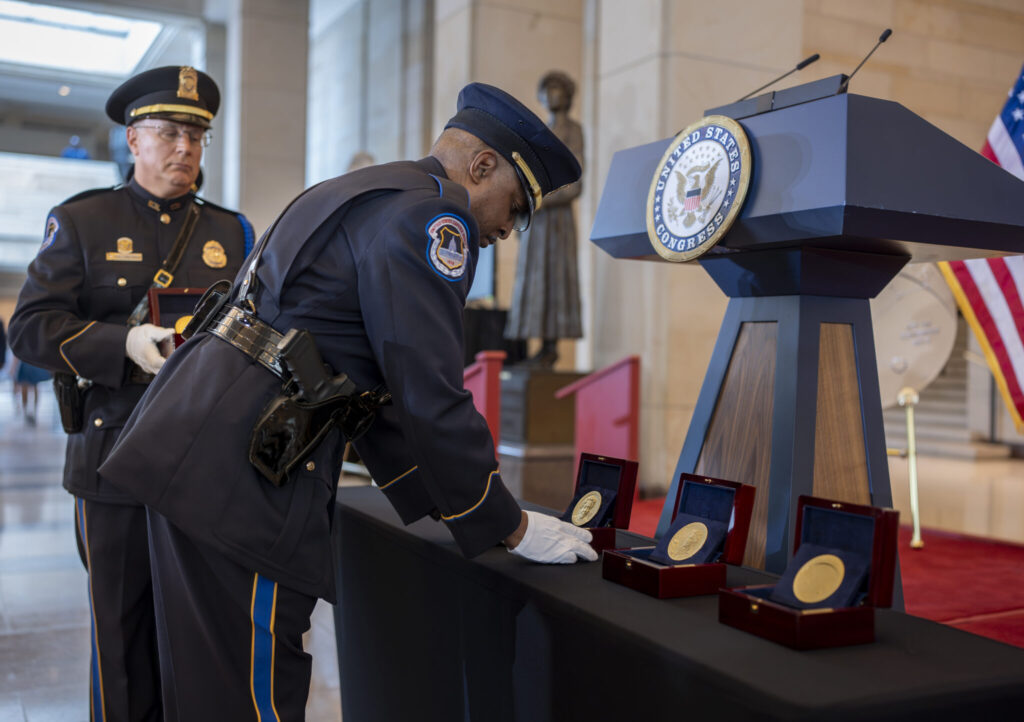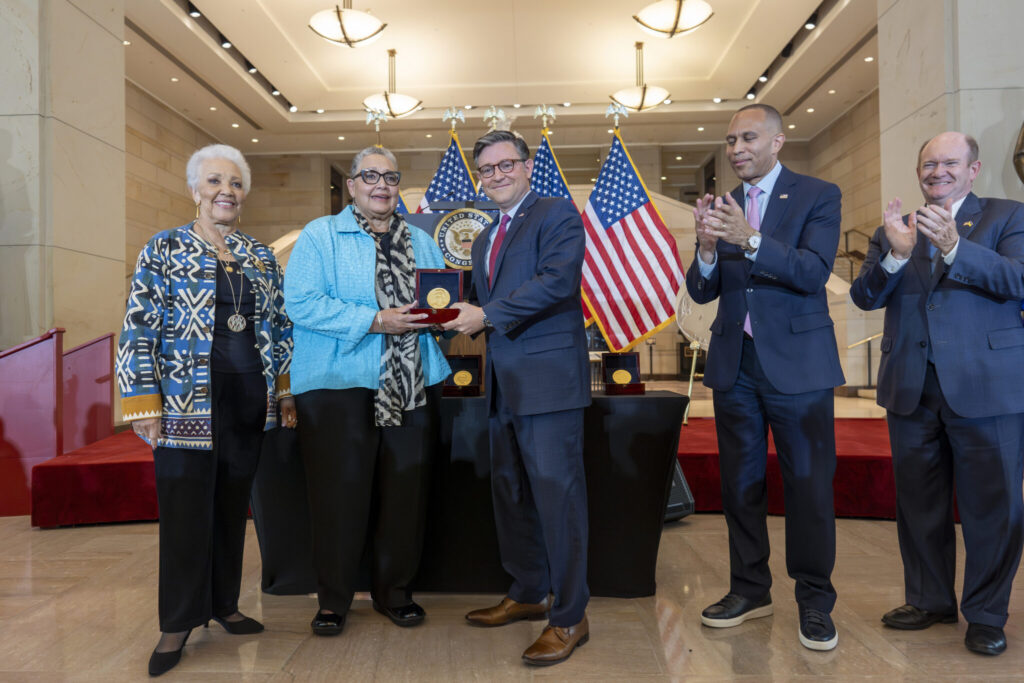Congress Awards Highest Honor to Pioneering Women of NASA \ Newslooks \ Washington DC \ Mary Sidiqi \ Evening Edition \ The Congressional Gold Medal was awarded posthumously to the families of Katherine Johnson, Dorothy Vaughan, Mary Jackson, and Christine Darden on Wednesday, recognizing their contributions to the U.S. space program. These women, along with all the mathematicians and engineers who worked as “human computers” from the 1930s to the 1970s, were honored for their groundbreaking work at NASA.

Congress Awards Hidden Figures with Congressional Gold Medal: Quick Looks
- Honorees: Congressional Gold Medals were awarded to the families of Katherine Johnson, Dorothy Vaughan, Mary Jackson, and Christine Darden.
- Additional recognition: All women who worked as “human computers” in the U.S. space program from the 1930s to the 1970s were also honored.
- Significant achievements: Johnson’s calculations enabled John Glenn’s orbital flight, Vaughan became NASA’s first Black supervisor, Jackson was NASA’s first Black female engineer, and Darden contributed to sonic boom research.
Hidden Figures of NASA Awarded Congressional Gold Medals: A Deeper Look
On Wednesday, the women whose calculations and innovations helped propel the United States to the forefront of space exploration were posthumously honored with the Congressional Gold Medal, the country’s highest civilian award. The legacies of Katherine Johnson, Dorothy Vaughan, Mary Jackson, and Christine Darden—pioneers who played critical yet unheralded roles in NASA’s success—were celebrated in a ceremony held at the U.S. Capitol. Although Johnson, Vaughan, and Jackson have passed away, their families accepted the medals on their behalf, while Christine Darden, who is still alive, viewed the event from her home in Connecticut.
In addition to these four trailblazing women, a medal was also given in recognition of the hundreds of women who worked behind the scenes as mathematicians, engineers, and “human computers” from the 1930s to the 1970s. Their contributions to the space program, though often overlooked, were instrumental in the success of missions that defined America’s early space endeavors.
Honoring the Women Behind the Space Race
The acknowledgment of these women, many of whom faced immense obstacles due to their race and gender, is a testament to their perseverance, brilliance, and lasting impact on American history. These “hidden figures” performed the mathematical calculations and engineering work necessary for some of the most important moments in space exploration. Yet for decades, their contributions were largely unrecognized.
Katherine Johnson, Dorothy Vaughan, Mary Jackson, and Christine Darden represent the best of these women—pioneers in their fields who not only excelled in their technical roles but also broke through racial and gender barriers that had long kept women of color from full participation in the scientific community.
Margot Lee Shetterly, the author of the book “Hidden Figures”, which was later adapted into an Academy Award-nominated film in 2016, emphasized the significance of this moment during her remarks at the ceremony. “By honoring them, we honor the very best of our country’s spirit,” Shetterly said, underscoring the courage, determination, and brilliance that these women brought to NASA during a critical period in the space race.
Congress Awards The Women Who Made NASA’s Success Possible
The recognition of these four women as Congressional Gold Medal recipients is a culmination of efforts to shed light on the critical roles they played in the U.S. space program, particularly during the Cold War era.
- Katherine Johnson, known for her brilliant mathematical mind, was responsible for the complex calculations that enabled John Glenn to become the first American astronaut to orbit the Earth in 1962. Glenn himself insisted that Johnson verify the numbers before he would agree to take off, a testament to her reputation for accuracy and precision. Johnson’s work helped ensure the safety of the mission and established her as one of NASA’s most indispensable minds. In 2015, Johnson received the Presidential Medal of Freedom, recognizing her contributions as a critical part of U.S. scientific history.
- Dorothy Vaughan broke barriers as NASA’s first Black supervisor. Starting as a mathematician at the National Advisory Committee for Aeronautics (NACA)—the predecessor to NASA—Vaughan led a team of women known as the “West Area Computers,” an all-Black, all-female computing group that performed complex calculations for NASA’s engineering projects. Under Vaughan’s leadership, the team played a vital role in various missions, and Vaughan herself became a champion for other women entering the field.
- Mary Jackson made history as NASA’s first Black female engineer. Initially hired as a mathematician, she transitioned into engineering after pushing to take advanced courses, a feat not common for women, especially Black women, at the time. Jackson’s work helped improve the aerodynamics of NASA’s spacecraft, and she eventually became a tireless advocate for other women and people of color in engineering.
- Christine Darden, the only one of the four honorees still living, became renowned for her pioneering work in sonic boom research. Over her 40-year career at NASA, Darden worked on supersonic flight and helped develop quieter and more efficient designs for supersonic jets, playing a key role in reducing the noise from sonic booms. Her work has had a lasting impact on both aeronautics and aerospace engineering.
A Legacy of Overcoming Barriers
The Congressional Gold Medals honor not only these four women but also the broader cohort of mathematicians, engineers, and “human computers” who worked from the 1930s to the 1970s. These women were hired by NACA to perform the calculations that would be used to design, test, and implement groundbreaking technologies. In an era of limited access to computers, these human computers were vital to ensuring the accuracy of critical data.
However, many of these women worked in obscurity and in segregated environments. The Black women hired during this time were forced to work in separate sections from their white colleagues, and despite their extraordinary contributions, they were often denied the recognition or professional advancement they deserved.
The struggle for equality that these women faced reflects broader societal challenges during the Jim Crow era and the early stages of the civil rights movement. Their perseverance, coupled with their outstanding technical achievements, paved the way for future generations of women and people of color in STEM fields.
The Importance of Recognizing Hidden Contributions
The ceremony at the U.S. Capitol is not just about celebrating these individuals but also acknowledging the systemic barriers they overcame. It serves as a reminder that progress in science and technology has often come from those who were overlooked or marginalized. By formally recognizing their contributions with Congress’ highest civilian honor, the country is taking an important step toward ensuring that their stories are remembered and inspire future generations.
The Congressional Gold Medals symbolize a long-overdue recognition of the women who helped propel the U.S. into space and solidified its position as a global leader in space exploration. Their work, which was once hidden from view, has now been brought to light, offering a fuller and more inclusive history of American innovation.
“Their contributions were indispensable to our success,” said one of the NASA administrators during the ceremony. “These women not only made history—they are history.”
Looking Forward: Inspiring the Next Generation
As the ceremony concluded, the focus shifted to how this recognition can inspire the next generation of women in science, technology, engineering, and mathematics (STEM). The stories of Katherine Johnson, Dorothy Vaughan, Mary Jackson, and Christine Darden serve as powerful examples for young women and people of color entering fields where they remain underrepresented.
Organizations like NASA and education advocates are using the visibility of these women’s stories to encourage more diversity in STEM fields. Schools across the country have begun incorporating these stories into their curriculums, ensuring that the legacy of the “hidden figures” endures and continues to motivate future generations of innovators.
Congress Awards Congress Awards Congress Awards







